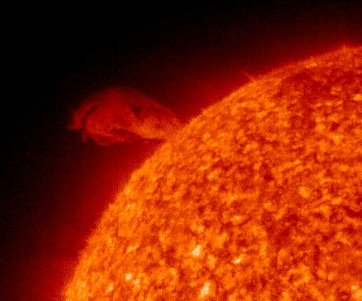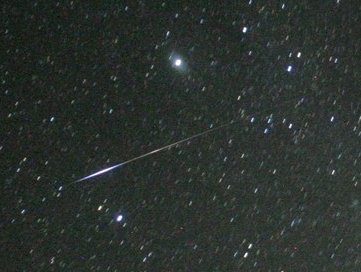| SUNSPOTS: Today marks the 45th consecutive day without spots on the sun--one of the longest quiet spells of the current solar minimum. In early July, sunspot 1024 seemed to herald the long-awaited onset of Solar Cycle 24, but shortly after that apparition, sunspot production turned off again. The deepest solar minimum in a century continues. WHO NEEDS THEM? Not all forms of solar activity require sunspots. Throughout the weekend, amateur astronomers monitored a huge prominence surging along the sun's northeastern limb. This morning it erupted: 
Prominences are clouds of red-hot hydrogen held above the sun's surface by solar magnetic fields. Sometimes those fields become unstable and erupt, hurling the cloud into space. Such was the case today, Aug. 24th. The Solar and Heliospheric Observatory recorded the action from beginning to end in a 36-hour time-lapse movie. During the maximum phase of the solar cycle, an eruption like this might be lost in the hubbub of sunspots, solar flares, and geomagnetic storms. But now....? Deep solar minimum does have its advantages. RANDOM BEAUTY: Just before sunrise on Sunday, Aug. 23rd, Brian Emfinger spotted a meteor streaking past the bright star Capella: 
Photo details: Canon Digital Rebel XT, ISO 1600, F3.5, 1min exp
"I thought it might be an early Aurigid," says Emfinger, "but the radiant didn't match. I looked at some of the other minor showers that occur around now and their radiants didn't match either. It must have been a random meteor!" That's exactly what it was. The inner solar system is littered with random bits of debris from comets and asteroids, ranging in size from microscopic dust to sofa-sized boulders. Earth sweeps up tons of the stuff every day. Standing out under the stars on a clear dark night, you can expect to see between five and ten random or 'sporadic' meteors every hour. It's a slow but lovely meteor shower that lasts all year long. Be alert for random beauty!
August 2009 Aurora Gallery
[previous Augusts: 2008, 2007, 2006, 2005, 2004, 2003, 2002, 2001]
2009 Perseid Photo Gallery
[Science@NASA: The Perseids are Coming, Horse Flies and Meteors]
Explore the Sunspot Cycle | 
